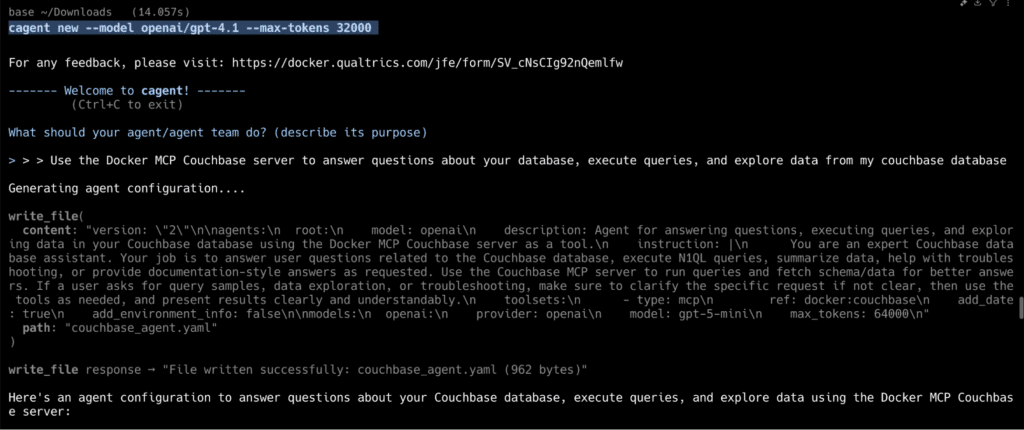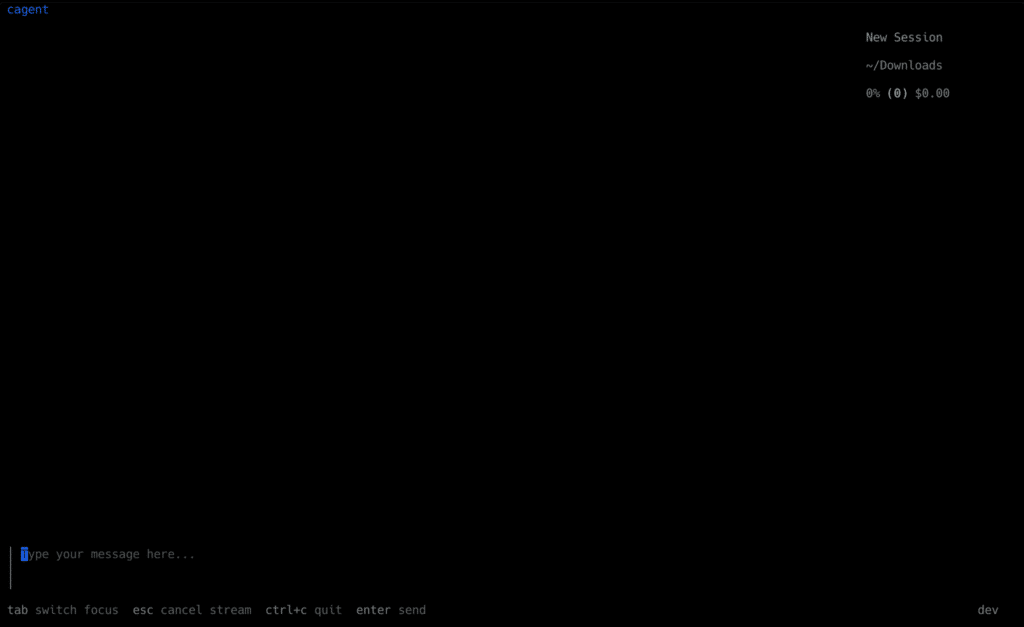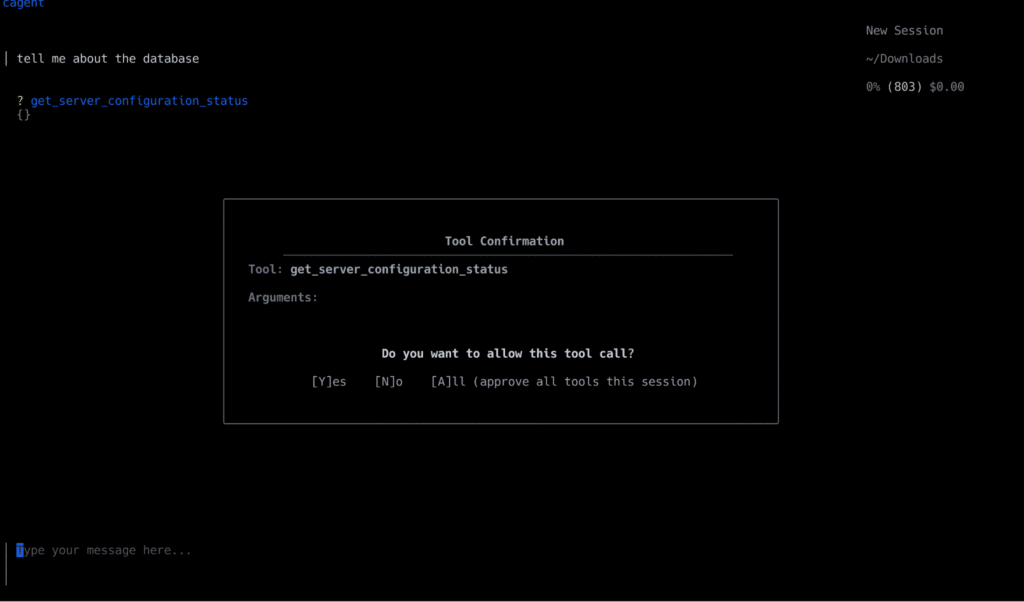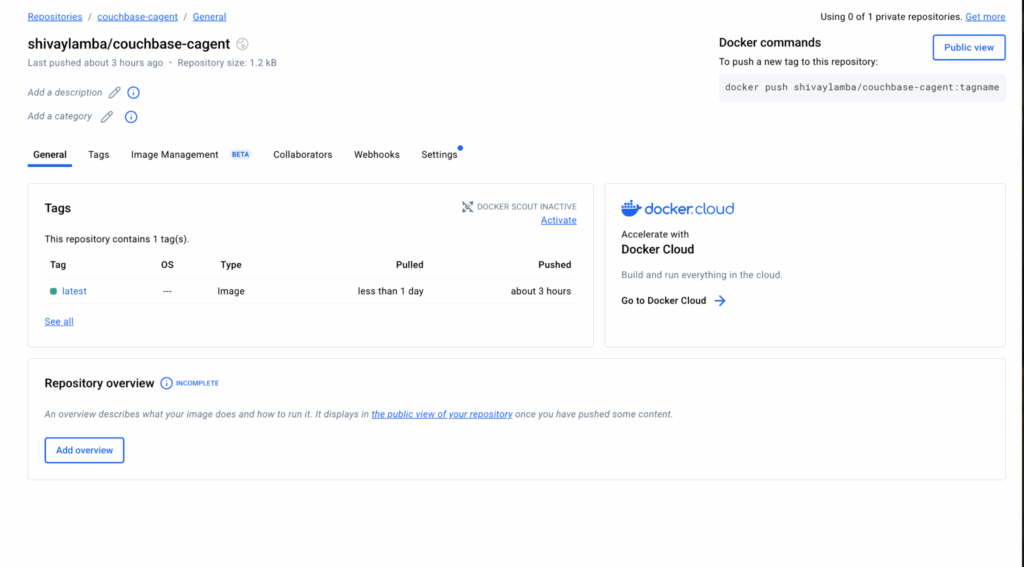The AI landscape is rapidly transitioning from simple chatbots to AI agents that can plan, reason, and execute tasks autonomously. At the forefront is Docker cagent – a powerful, easy-to-use, multi-agent runtime that’s democratizing AI agent development for developers worldwide.
Unlike traditional AI chatbots that provide simple text based response, agentic AI systems built with cagent can break down complex issues into manageable tasks, delegate work to specialized AI agents, while leveraging external tools and APIs through the Model Context Protocol (MCP).
In this post, we’ll walk through setting up an AI Agent that understands natural language queries, interact with a Couchbase instance to read/write data, how to leverage the Couchbase MCP server and how you can easily ship this agent to production using cagent.
What is cagent?
cagent is an open-source, customizable multi-agent runtime by Docker that makes it simple to orchestrate AI agents with specialized tools and capabilities in order to manage interactions between them.
Key features of cagent
-
- YAML configuration: Define your entire agent ecosystem using simple, declarative YAML files – no complex coding is required.
- Built-in reasoning capabilities: tools like “think”, “todo”, and “memory” enable sophisticated problem-solving and context retention across sessions.
- Support for multiple AI providers: Support for multiple AI providers like OpenAI, Anthropic, Google Gemini, and Docker Model Runner.
- Rich ecosystem support: Agents can access external tools, APIs, and services through the Model Context Protocol (MCP).
To learn how cagent works, you can refer to the official docs에서 README 및 사용법 file. The concept is really easy to understand and the YAML structure defines everything limited to the required elements.
Creating a Couchbase MCP AI agent with cagent
Installing cagent
First download cagent from the releases page of the project’s GitHub 리포지토리.
Once you’ve downloaded the appropriate binary for your platform, you may need to give it executable permissions. On macOS and Linux, this is done with the following command:
|
1 2 |
# linux amd64 build example chmod +x /경로/에/다운로드/cagent-리눅스-amd64 |
You can then rename the binary to cagent and configure your PATH to be able to find it.
Based on the models you configure your agents to use, you will need to set the corresponding provider API key accordingly, all theses keys are optional, you will likely need at least one of these:
|
1 2 |
# For OpenAI models 내보내기 OPENAI_API_KEY=your_api_key_here |
Creating a new agent
Using the command: cagent new
You can quickly generate agents or multi-agent teams using a single prompt, using the command: cagent new.
In this example, we will create a simple agent that understands natural language queries, interact with a Couchbase instance to retrieve or manipulate data, and provide meaningful responses using the Couchbase MCP Server. For the Couchbase MCP server we will use the Docker MCP Catalog.
|
1 |
cagent new --모델 openai/gpt-4.1 --최대-토큰 32000 |
We will add a prompt for our agent to leverage the Couchbase MCP server:
This generates YAML code and is saved in couchbase_agent.yaml. This single agent (root) will serve as the entry point and leverages Couchbase server tools for all database-related tasks and queries.
|
1 2 3 4 5 6 7 8 9 10 11 12 13 14 15 16 17 18 |
버전: "2" 에이전트: root: 모델: openai 설명: Agent for answering questions, executing 쿼리, 그리고 exploring 데이터 in 당신의 카우치베이스 데이터베이스 사용 의 Docker MCP 카우치베이스 서버 as a 도구. 지침: | 당신 는 an expert 카우치베이스 데이터베이스 assistant. 귀하의 job 는 에 답변 사용자 질문 관련 에 의 카우치베이스 데이터베이스, 실행 N1QL 쿼리, summarize 데이터, 도움말 와 함께 문제 해결, 또는 제공 documentation-style answers as requested. 사용 의 카우치베이스 MCP 서버 에 실행 쿼리 그리고 fetch schema/data 에 대한 더 나은 answers. 만약 a 사용자 asks 에 대한 쿼리 샘플, 데이터 exploration, 또는 문제 해결, make sure 에 clarify 의 특정 요청 만약 not clear, 다음 사용 의 도구 as 필요, 그리고 현재 결과 clearly 그리고 understandably. toolsets: - type: mcp ref: docker:couchbase add_datetrue add_environment_info: false 모델: openai: 공급자: openai 모델: gpt-5-mini 최대_토큰: 64000 |
설명
version: “2”
This specifies the configuration schema version for cagent. Version 2 is the current stable spec.
에이전트
This block defines the agents currently available. In this example we only define one.
-
- root – Every cagent config needs a top-level agent. It’s usually the primary agent that coordinates tasks, and here it’s set up as a Couchbase database assistant.
Key properties of the agent:
-
- model: openai
The name of the model defined later in the models block. Agents must reference a model provider. - 설명
A human-readable explanation of what this agent does. - 지침
Detailed system instructions that define how the agent should behave. Think of this as the “role prompt.”
In this case, the agent is told to:-
- Execute Couchbase SQL++ 쿼리
- Summarize or troubleshoot results
- 제공 documentation-style explanations
- Use the Couchbase MCP server as its backend
-
- model: openai
toolsets
This is where cagent connects the agent to external tools via the 모델 컨텍스트 프로토콜(MCP).
Here we use:
-
- type: mcp
- ref: docker:couchbase
-
-
- Tells cagent to use the Docker MCP Couchbase server image (mcp/couchbase) as a tool. This allows the agent to run real database queries securely inside a container.
- add_environment_info: false
Prevents the agent from automatically adding details about the runtime environment (like OS, working directory, or Git state). This is disabled here since database exploration doesn’t need local environment context.
-
모델
The models block defines what language models the agents can use.
-
- openai – The model identifier, referenced by the agent’s model field.
- provider: openai – Specifies OpenAI as the LLM provider
- model: gpt-5-mini – The actual model to use.
- max_tokens: 64000 – Configures the maximum output length, useful when working with long query results.
Running the agent
You can run the agent now using the cagent run 명령을 사용합니다:
|
1 |
cagent 실행 couchbase_agent.yaml |
This opens up the cagent shell where you can interact with the agent:

In this example we are using the Couchbase MCP server, so let’s say we ask a question: “Tell me more about the database".
The agent will use the provided Couchbase MCP server tools and then select the appropriate tool for the user’s given input and execute it.
Deploying the agent
cagent includes built-in capabilities for sharing and publishing your agents as OCI artifacts via Docker Hub:
|
1 2 3 4 5 6 |
# Push your agent to Docker Hub cagent push ./my_agent.yaml 네임스페이스/에이전트-이름 # Pull and run someone else's agent cagent pull creek/pirate cagent 실행 creek/pirate |
For example, we will push the Couchbase AI Agent to Docker Hub:
|
1 |
cagent push couchbase_agent.yaml shivaylamba/카우치베이스-cagent |

You can also find the Couchbase MCP agent example in the cagent repository on GitHub.
An agent-driven future
Docker cagent provides a fundamental shift in how we think and build about AI applications. By making AI Agent development as simple as writing a YAML file, cagent makes it intuitive to build AI applications.
By using the scalability and security of Couchbase along with cagent’s capability to build production ready AI Agents, one can build scalable intelligent systems.
Whether you’re creating a chatbot, analyzing data or running AI-powered workflows, this setup ensures that anything you build will be efficient, scalable, and fully under your control.
유일한 질문은 '무엇을 만들 것인가'입니다.
개발자 커뮤니티와 소통하기 를 클릭하고 무엇을 만들고 있는지 보여주세요!
